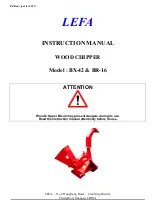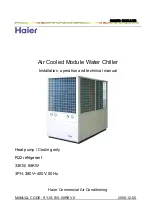
44
RTAA-SVX01A-EN
Installation — Remote Evaporator
Piping Installation Procedures
The outdoor unit and the evaporator are shipped with a 25 psig holding
pressure of dry nitrogen. Do not relieve this pressure until field installation of
the refrigerant piping is to be accomplished. This will require the removal of
the temporary pipe caps.
NOTE:
Use Type L refrigerant-grade copper tubing only.
The refrigerant lines must be isolated to prevent line vibration from being
transferred to the building. Do not secure the lines rigidly to the building at
any point.
All horizontal suction lines should be pitched downward, in the direction of
flow, at a slope of 1/2 in. per 10 feet of run. This allows for larger line size,
which will improve unit efficiency.
Important: Relieve nitrogen pressure before removing end caps.
Do not use a saw to remove end caps, as this may allow copper chips to
contaminate the system. Use a tubing cutter or heat to remove the end caps.
WARNING
Prevent Injury!
When sweating line connections, always provide a sufficient
purge of dry nitrogen through the tubing to prevent the formation
of oxides/scaling cause by high temperature from brazing. Use a
pressure regulator in the line between the unit and the high
pressure nitrogen cylinder to avoid over pressurization and
possible explosion. If any refrigerant or refrigerant vapors are
present a thorough purge with dry nitrogen will prevent the
possible formation of toxic phosgene gas. Failure to follow these
recommendations could result in death or serious injury.
Refrigerant Sensors
The suction line refrigerant sensors must be installed by the contractor
installing the refrigerant piping. The sensors are prewired and each is
“wire-tied” to its respective liquid line. Fittings and adapters for mounting of
the sensors are located in the remote evaporator terminal box. See
Figure 24
for mounting instructions.
Summary of Contents for RTAA-100
Page 110: ...110 RTAA SVX01A EN Start Up Procedures Figure 37 Unit Sequence of Operation...
Page 143: ...RTAA SVX01A EN 143 Pump Package Figure 47 Pump Package Piping Schematic...
Page 144: ...144 RTAA SVX01A EN Pump Package...
Page 146: ...146 RTAA SVX01A EN 3327...
Page 147: ...RTAA SVX01A EN 147...
Page 148: ...148 RTAA SVX01A EN 3328...
Page 149: ...RTAA SVX01A EN 149...
Page 150: ...150 RTAA SVX01A EN 6516...
Page 151: ...RTAA SVX01A EN 151...
Page 152: ...152 RTAA SVX01A EN 3329...
Page 153: ...RTAA SVX01A EN 153...
Page 154: ...154 RTAA SVX01A EN 6472...
Page 155: ...RTAA SVX01A EN 155...
Page 156: ...RTAA SVX01A EN 156 3330...
Page 157: ...157 RTAA SVX01A EN...
Page 158: ...158 RTAA SVX01A EN 6046...
Page 159: ...RTAA SVX01A EN 159...
Page 160: ...160 RTAA SVX01A EN 3331...
Page 161: ...RTAA SVX01A EN 161...
Page 162: ...162 RTAA SVX01A EN 6519...
Page 163: ...RTAA SVX01A EN 163...
Page 164: ...164 RTAA SVX01A EN 6047...
Page 165: ...RTAA SVX01A EN 165...
Page 166: ...166 RTAA SVX01A EN 3325...
Page 167: ...RTAA SVX01A EN 167...
Page 168: ...168 RTAA SVX01A EN 6048...
Page 169: ...RTAA SVX01A EN 169...
Page 172: ...172 RTAA SVX01A EN 3326...
Page 173: ...RTAA SVX01A EN 173...
Page 174: ...174 RTAA SVX01A EN 6049...
Page 175: ...RTAA SVX01A EN 175...
Page 176: ...176 RTAA SVX01A EN 6463...
Page 177: ......
















































